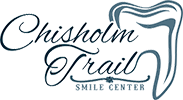If you’ve been diagnosed with gum disease (periodontitis) and have gum recession, you may have had a gingival graft or connective tissue graft recommended by your dentist or periodontist. While the prospect of gum surgery can sound frightening, the purpose behind treatments like these is to help you hold onto your teeth for as long as you can. Gum surgery is an excellent way to fight gum recession and help ensure your teeth stay protected and stable in your mouth.
Do you suffer from gum recession? Dr. Matthew Bridges can help restore your gums with gum grafting and connective tissue grafting at Chisholm Trail Smile Center. Call our Duncan, OK dental office at (580) 255-4880 to make an appointment.
Why Would I Need Grafting?
When bacteria infect the gum tissue, they are constantly excreting harmful acids. These are the same acids that can leach minerals from tooth enamel and initiate the start of a dental cavity. However, when these acids come in contact with your gum tissue for long enough, they cause the tissue to die. This usually happens at the gum line first, and thus leads to recession of the gums. When teeth start to look longer, as though the tissue is pulling back away from the teeth, this indicates that your gum tissue is being destroyed.
The reason why gum recession is a critical situation is because your teeth need gingival tissue to stay stable in your mouth. Gingival tissues form an elastic-like membrane that holds the tooth roots in place and resist the force of biting, chewing, and brushing the teeth. The same way that a plant needs soil to support it, your teeth need adequate gum tissue to stand in your mouth.
Gum grafting and connective tissue grafting use donor tissue from another part of your mouth to replace lost gingival tissues. This can help ensure your tooth roots stay supported and are better protected from mouth bacteria. When a recommended gum graft is not performed, the tissue will continue to pull away from the teeth and roots, and tooth loss becomes a potential outcome. You also have a greater chance of developing tooth decay below the surface of the gums, which is harder to treat than cavities in the crown of a tooth.
How Are Gingival Grafts Different from Connective Tissue Grafts?
There are two types of gingival (gum) tissue that support the teeth. The pink gum tissue that you see surrounding the teeth is dense and forms a tight seal around the teeth. However, below this tissue, lies a thinner, red-colored tissue that called the mucosa, which protects and supports the roots.
The purpose of gingival connective tissue grafting is to protect the roots of the tooth by adding to the gingival mucosa that sits below the gums. Donor tissue from beneath the soft palate of your mouth is used to thicken and strengthen this connective tissue. A free gingival graft uses tissue directly from the roof of the mouth to add to the keratinized gum tissue you see around your teeth. As the donor tissues heal in place, they add to the bulk of gingival tissues that surround and protect the teeth and roots, to make up for the loss caused by bacterial damage.
What Happens During Gum Surgery?
Both kinds of gum grafting surgery can be completed in our office, and take about 45 minutes. You will be given an anesthetic injection to ensure you feel no sensitivity during the appointment. You may also be given a sedative to help you relax and stay comfortable during the procedure. If you are given a sedative, you will need to have a friend or family member drive you home afterward.
After the treatment, your mouth will be sore, and you will have sutures. It takes about one to two weeks to heal, so you will need to be gentle on your mouth, and eat only soft, cold foods that don’t irritate your teeth or gums. You will not be able to brush or floss for about two weeks, so we will give you detailed instructions on how to clean your mouth and a prescription rinse to use.
To learn more about gingival grafts and connective tissue grafts, contact Chisholm Trail Smile Center for an appointment with Dr. Bridges. Call our Duncan, OK dental office at (580) 255-4880 to make an appointment.







